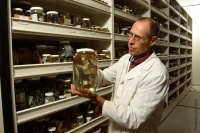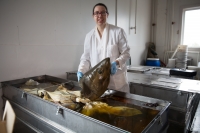
Museum Collections
The Atlantic Reference Centre is a research museum of Atlantic Canadian marine life. We’re known as the ARC, like Noah’s ark, because we like to keep an example of everything we find. The museum is a partnership between Huntsman Marine Science Centre and the Department of Fisheries and Oceans. We have more than 150 000 lots of specimens of marine animals ranging from tiny plankton to large sharks. Most of the specimens come from the waters of Atlantic Canada. Scientists use the ARC collections for their research and to help them identify animals.
Dive DeeperTechnology Interview
Who works at the ARC museum?
At the ARC we have two curators who look after our collections: me (Claire Goodwin) and Rebecca Milne. We also have lots of help from our team of Huntsman technicians. Torben Brydges, a technician in Fisheries and Oceans Canada, manages the day-to-day operations of the museum.
What do people use the museum for?
As a scientist, you have to know what species you’re studying. How can you check your identifications are correct? Of course, there are always identification books and websites. But sometimes it helps to see the real thing, and compare your samples with something an expert has identified. Scientists can come visit us to see our specimens, or borrow them by mail.
What is a taxonomist? What is a type specimen?
A taxonomist is a scientist who works on taxonomy: classifying and describing organisms. When a taxonomist describes a species new to science, they have to place a holotype specimen in a museum. This is the specimen they’ve based their published scientific description on. When I describe new species, I have to go and look at holotypes of similar species to check that my species is different. It’s exciting to examine a specimen that might be a hundred years old or more. I even got to hold some of Darwin's specimens in the British Natural History Museum. The original labels are often in with the specimen, complete with beautifully neat handwriting (something I need to work on as a curator!).
Why bother to keep specimens?
The specimens we hold in our collections are physical proof that a species was present at a particular time and place. Scientists can also deposit voucher collections of specimens with us from specific projects. This lets anyone in the future check that the identification was correct.

ARC specimens are carefully catalogued and stored on purpose-built museum shelving. Here former ARC curator Lou Van Guelpen examines a fish specimen. (Photo: Huntsman Marine Science Centre)
What other uses are there for museum collections?
As well as providing a record of a species, physical specimens provide a wealth of material for scientists to study. Many scientists now use DNA to study the relationships between different species and populations. We can extract DNA from even very old museum specimens. Sometimes the study of museum specimens leads to changes in species names. For example, studies of dolphin skulls resulted in the splitting of bottlenose dolphins into two species.
Many collections have specimens collected over a long period. This allows scientists to study how species have changed over time. The ARC collections date back to the early 1900s and have collections of larval lobster spanning most of the 20th century. We could use these specimens to study lobster diet using stable isotope analysis. We could also look at how chemicals in the seawater have affected lobster populations.
How are the museum specimens preserved?
One of the questions I am asked most often by children is whether I killed everything in our collection. Well, no, not personally! But all our specimens are dead. Scientists are careful to collect as little as possible for their study. To stop specimens from rotting, we have to preserve them. We store most of our specimens in alcohol (ethanol or isopropanol). Sometimes we need to “fix” them in formalin first to preserve their shape. Animals are often not very happy when you remove them from their home and they can shrivel up. This makes studying them hard. To stop this, we “relax” (anaesthetize) them before fixing them. It's quite relaxing for me too as a lot of the chemicals used, such as menthol and clove oil, smell nice. Once preserved, specimens can last for hundreds of years if kept in suitable conditions.

Large specimens are kept in tanks. Here Rebecca Milne holds the head of a porbeagle shark. (Photo: Daniela Sneppova)
Is it difficult to find a particular specimen in the museum?
With over 150 000 specimens, how do we find anything? The first step is making sure that specimens have clear labels. These include the name of the species, location and date collected, who collected them, and any other important information. Once we’ve physically labelled a specimen, we also put the information into our computerized museum database. In the ARC our specimens are all housed on special rolling shelving and we use codes to tell us which shelf they should be on. If we take things off the shelf, we have to be very careful to put them back in the right place!
Can I see what specimens you have?
You can search our specimens using the Ocean Biodiversity Information System (OBIS) (obis.org). Many museums and research institutions contribute information. On OBIS, scientists can look at species distributions and find specimens for their research with ease.

While the majority of ARC specimens are from Atlantic Canada, we have material from all over the world. The ARC database is made publically accessible via the Ocean Biodiversity Information System. (Photo: Ocean Biodiversity Information System/ Global Biodiversity Information Facility.)



